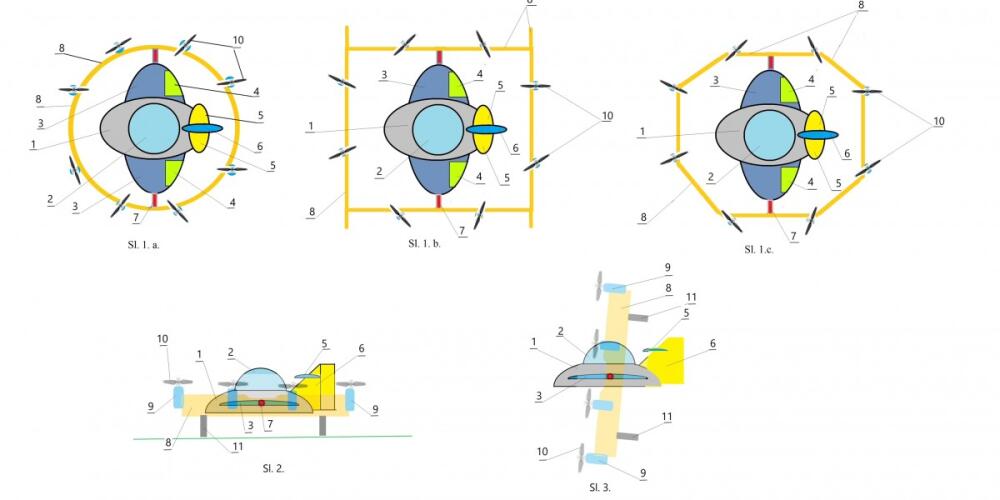
In recent years, many authoring teams have been encouraged by grand prizes, mostly in the US with made cars that can take off vertically and fly at shorter distances.
Flying machines can be divided into airplanes, helicopters and rockets. Planes need a runway to take off and land, while helicopters take off from one place, and can land wherever there is enough space.
In airplanes, the engines push forward, and in the air they hold the buoyancy created by the wings.
In helicopters, engines with large propellers lift the helicopter in the air and keep it in the air throughout the flight. Because of this, helicopters consume much more energy during flight.
There are planes that can take off like helicopters, and in the air the propellers with the engine turn forward, thus turning into planes.
Many small drones are essentially airplanes, or unmanned helicopters. Such drones usually have a large number of propeller engines that are located around the entire body of the aircraft. This arrangement of propeller engines makes it easier to drive vehicles and move in all directions. Cars like this have already been made that can transport passengers over shorter distances.
Such flying machines can be partially converted into airplanes in flight by turning the side propellers with the engine, but the problem is that the front and rear propellers cannot be easily rotated, so these vehicles still fly like helicopters and consume a lot of energy.
The problem of turning the engine and propeller can be easily solved by placing them on a narrow and deep bearing ring (8) located around the vehicle shown in these figures.
Figure No. 1 shows vehicles on the ground seen from above, in three versions. The first embodiment of the support ring (8) is in the shape of a circle (Fig.1.a.), the second in the shape of a square (Fig.1.b.) and the third in the shape of an octagon (Fig.1.c.). Figure 2 shows a side view of the vehicle while on the ground, while Figure 3 shows a side view of the vehicle in flight.
The bearing ring (8) carries the hull (1) over the axles (7) located on top of the small wings (3). When raising and lowering the vehicle, the support ring (8) is placed horizontally in relation to the ground, and by starting the engine (9) with the propellers (10), the vehicle is lifted into the air. In the air, the entire support ring (8) rotates forward on the axles (7), and the propellers (10) begin to pull the entire vehicle forward. This creates buoyancy on the small wings (3), but also on the ring itself (8), which with its front and rear part turns into a wing that creates buoyancy upwards. In this way, this vehicle rises like a helicopter with the help of engine power, and flies like an airplane with the help of buoyancy force.
In flight, the lateral position of the fuselage (1) is maintained by means of flaps (4) which, by turning, can tilt the vehicle laterally to the left and right. At the rear end of the hull (1) there is a vertical stabilizer (6) which has rear flaps (5) which by their rotation can tilt the longitudinal position of the hull (1) forward or backward.
If the vehicle is to be turned to the left then the right engines should increase their work and if it is to be turned to the right then the left side engines should increase their work.
When landing, the support ring (8) is repositioned in a horizontal position and the vehicle is lowered to the ground.
Thanks to buoyancy, the consumption of such a vehicle would be lower than with existing models. The starting energy could be provided by batteries located in the middle of the hull bottom (1). With this solution, with the help of the existing best batteries, the vehicle could fly for more than half an hour how much can existing drones can fly.
A better solution would be to place a small air-cooled motor with a generator that produces electricity on the bottom of the hull (1). Instead of an engine, the generator could be powered by a small gas turbine. The electricity thus produced would power the engines (9) as well as all other systems in the vehicle. There should be enough energy in the batteries to start the engine, but also for an emergency start in the event of a failure of the engine that drives the generator, or a failure of the generator itself. The vehicle would stand on the ground on legs (11) located at the bottom of the ring (8). When a man enters the vehicle, the man would climb on the wing (3) from the side, lift the glass or plastic dome (2), and enter the fuselage (1) of the vehicle. It would be the same way to get out of the vehicle.
Other of my technical analyzes and innovations can be found in this book.
Tags
Featured articles